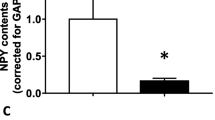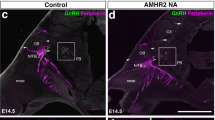Abstract
Wide application of gonadotropin-releasing hormone (GnRH) agonists and antagonists for clinical purposes determines their effects on ovarian signaling pathways. Our study aimed to determine the localization, expression levels of Wnt signaling members in the pubertal and adult mouse ovary and the impact of GnRH antagonist cetrorelix on these signaling members. 0.5 mg/kg of cetrorelix was injected to 3-and 6-week-old mice for 2 weeks. At the end of injection, ovaries from 5 (5Ce)- to 8-week (8Ce)-old mice were embedded in paraffin for immunohistochemistry and homogenized for western blot to compare with control (5C–8C) and sham groups (5S–8S). WNT2 and WNT4 showed higher expression in thecal and stromal cells in adult mouse ovaries and only WNT4 expression was affected by cetrorelix. FZD1 was localized mainly in oocytes of pubertal ovaries and granulosa cells and oocytes of adult ovaries. FZD1 was reduced by cetrorelix in pubertal ovaries. FZD4 was abundantly localized in thecal and stromal cells of all groups and protein level was not affected by cetrorelix. LRP-6 was expressed mainly in oocytes and stromal cells of pubertal, oocytes of adult ovaries and its expression was reduced by cetrorelix in adult ovaries. CTNNB1 intensity in granulosa cells was the lowest in pubertal and the highest in adult ovaries and its expression was decreased by cetrorelix in adult ovaries. Cetrorelix affected the expression of specific members of the Wnt signaling depending on the developmental stage of mice, pointing out its possible interaction with gonadotropins during pubertal and adult stages.












Similar content being viewed by others
References
Abdul-Ghani M et al (2011) Wnt11 promotes cardiomyocyte development by caspase-mediated suppression of canonical Wnt signals. Mol Cell Biol 31(1):163–178
Abedini A et al (2016) WNT5a is required for normal ovarian follicle development and antagonizes gonadotropin responsiveness in granulosa cells by suppressing canonical WNT signaling. FASEB J 30(4):1534–1547
Bienz M, Clevers H (2003) Armadillo/beta-catenin signals in the nucleus–proof beyond a reasonable doubt? Nat Cell Biol 5(3):179–182
Boyer A et al (2010) WNT4 is required for normal ovarian follicle development and female fertility. FASEB J 24(8):3010–3025
Castanon BI et al (2012) Follicle-stimulating hormone regulation of estradiol production: possible involvement of WNT2 and beta-catenin in bovine granulosa cells. J Anim Sci 90(11):3789–3797
Chen W et al (2005) Gonadotropin-releasing hormone antagonist cetrorelix down-regulates proliferating cell nuclear antigen and epidermal growth factor expression and up-regulates apoptosis in association with enhanced poly(adenosine 5′-diphosphate-ribose) polymerase expression in cultured human leiomyoma cells. J Clin Endocrinol Metab 90(2):884–892
Clevers H (2006) Wnt/beta-catenin signaling in development and disease. Cell 127(3):469–480
Edson MA et al (2009) The mammalian ovary from genesis to revelation. Endocr Rev 30(6):624–712
Fan HY et al (2010) Beta-catenin (CTNNB1) promotes preovulatory follicular development but represses LH-mediated ovulation and luteinization. Mol Endocrinol 24(8):1529–1542
Furukawa KT, Yamashita K et al (2017) The epithelial circumferential actin belt regulates YAP/TAZ through nucleocytoplasmic shuttling of Merlin. Cell Rep 20(6):1435–1447
Grundker C et al (2000) Luteinizing hormone-releasing hormone agonist triptorelin and antagonist cetrorelix inhibit EGF-induced c-fos expression in human gynecological cancers. Gynecol Oncol 78(2):194–202
Gupta PS et al (2014) Regulation and regulatory role of WNT signaling in potentiating FSH action during bovine dominant follicle selection. PLoS One 9(6):e100201
Harwood BN et al (2008) Members of the WNT signaling pathways are widely expressed in mouse ovaries, oocytes, and cleavage stage embryos. Dev Dyn 237(4):1099–1111
Hernandez Gifford JA et al (2009) Conditional deletion of beta-catenin mediated by Amhr2cre in mice causes female infertility. Biol Reprod 80(6):1282–1292
Hernandez-Gonzalez I et al (2006) Gene expression profiles of cumulus cell oocyte complexes during ovulation reveal cumulus cells express neuronal and immune-related genes: does this expand their role in the ovulation process? Mol Endocrinol 20(6):1300–1321
Honda T et al (2010) PDZRN3 negatively regulates BMP-2-induced osteoblast differentiation through inhibition of Wnt signaling. Mol Biol Cell 21(18):3269–3277
Horvath JE et al (2002) Effects of long-term treatment with the luteinizing hormone-releasing hormone (LHRH) agonist Decapeptyl and the LHRH antagonist Cetrorelix on the levels of pituitary LHRH receptors and their mRNA expression in rats. Proc Natl Acad Sci USA 99(23):15048–15053
Hsieh M et al (2002) Regulated expression of Wnts and Frizzleds at specific stages of follicular development in the rodent ovary. Endocrinology 143(3):898–908
Khalaf M et al (2010) GnRH agonist and GnRH antagonist protocols in ovarian stimulation: differential regulation pathway of aromatase expression in human granulosa cells. Reprod Biomed Online 21(1):56–65
Lapointe E et al (2012) FZD1 regulates cumulus expansion genes and is required for normal female fertility in mice. Biol Reprod 87(5):104
Law NC et al (2013) Lhcgr expression in granulosa cells: roles for PKA-phosphorylated beta-catenin, TCF3, and FOXO1. Mol Endocrinol 27(8):1295–1310
Lee HY et al (2004) Instructive role of Wnt/beta-catenin in sensory fate specification in neural crest stem cells. Science 303(5660):1020–1023
Lowry OH et al (1951) Protein measurement with the Folin phenol reagent. J Biol Chem 193(1):265–275
Maman E et al (2011) Expression and regulation of sFRP family members in human granulosa cells. Mol Hum Reprod 17(7):399–404
Matikainen T et al (1992) Differing responses of plasma bioactive and immunoreactive follicle-stimulating hormone and luteinizing hormone to gonadotropin-releasing hormone antagonist and agonist treatments in postmenopausal women. J Clin Endocrinol Metab 75(3):820–825
Nusse R, Varmus HE (1992) Wnt genes. Cell 69(7):1073–1087
Parakh TN et al (2006) Follicle-stimulating hormone/cAMP regulation of aromatase gene expression requires beta-catenin. Proc Natl Acad Sci USA 103(33):12435–12440
Pinson KI et al (2000) An LDL-receptor-related protein mediates Wnt signalling in mice. Nature 407(6803):535–538
Prunskaite-Hyyrylainen R et al (2014) Wnt4, a pleiotropic signal for controlling cell polarity, basement membrane integrity, and antimullerian hormone expression during oocyte maturation in the female follicle. FASEB J 28(4):1568–1581
Richards JS et al (2002) Novel signaling pathways that control ovarian follicular development, ovulation, and luteinization. Recent Prog Horm Res 57:195–220
Ricken A et al (2002) Wnt signaling in the ovary: identification and compartmentalized expression of wnt-2, wnt-2b, and frizzled-4 mRNAs. Endocrinology 143(7):2741–2749
Roose J et al (1998) The Xenopus Wnt effector XTcf-3 interacts with Groucho-related transcriptional repressors. Nature 395(6702):608–612
Saatli B et al (2009) Long-term effects of GnRH agonist, GnRH antagonist, and estrogen plus progesterone treatment on apoptosis related genes in rat ovary. Fertil Steril 91(5 Suppl):2006–2011
Salker MS et al (2018) LEFTY2 inhibits endometrial receptivity by downregulating Orai1 expression and store-operated Ca(2+) entry. J Mol Med (Berl) 96(2):173–182
Spate LD et al (2014) Dickkopf-related protein 1 inhibits the WNT signaling pathway and improves pig oocyte maturation. PLoS One 9(4):e95114
Stapp AD et al (2014) Canonical WNT signaling inhibits follicle stimulating hormone mediated steroidogenesis in primary cultures of rat granulosa cells. PLoS One 9(1):e86432
Tepekoy F et al (2015a) The role of Wnt signaling members in the uterus and embryo during pre-implantation and implantation. J Assist Reprod Genet 32(3):337–346
Tepekoy F et al (2015b) CD90 and CD105 expression in the mouse ovary and testis at different stages of postnatal development. Reprod Biol 15(4):195–204
Usongo M et al (2012) beta-Catenin/Tcf signaling in murine oocytes identifies nonovulatory follicles. Reproduction 144(6):669–676
Vainio S et al (1999) Female development in mammals is regulated by Wnt-4 signalling. Nature 397(6718):405–409
Wang HX et al (2009) Identification of WNT/beta-CATENIN signaling pathway components in human cumulus cells. Mol Hum Reprod 15(1):11–17
Wang HX et al (2010) WNT2 regulates DNA synthesis in mouse granulosa cells through beta-catenin. Biol Reprod 82(5):865–875
Wei W et al (2006) The LDL receptor-related protein LRP6 mediates internalization and lethality of anthrax toxin. Cell 124(6):1141–1154
Wu MH et al (2005) Clinical suppression of precocious puberty with cetrorelix after failed treatment with GnRH agonist in a girl with gonadotrophin-independent precocious puberty. Reprod Biomed Online 11(1):18–21
You L et al (2004) Inhibition of Wnt-2-mediated signaling induces programmed cell death in non-small-cell lung cancer cells. Oncogene 23(36):6170–6174
Acknowledgements
This study was supported by the Scientific Research Projects Coordination Unit of Akdeniz University (Project Number: 2012.01.0103.003).
Author information
Authors and Affiliations
Contributions
FT and FU carried out cetrorelix injections, tissue processing, and immunohistochemistry experiments and performed evaluation and the statistical analysis for immunohistochemistry. FT and NA applied western blot experiments and performed the statistical analysis for western blot results. IU and GA conceived of the study, participated in its design and coordination and helped to draft the manuscript. All authors read and approved the final manuscript.
Corresponding author
Ethics declarations
Conflict of interest
All authors declare that they have no competing interests.
Additional information
Publisher's Note
Springer Nature remains neutral with regard to jurisdictional claims in published maps and institutional affiliations.
Rights and permissions
About this article
Cite this article
Tepekoy, F., Uysal, F., Acar, N. et al. The effect of GnRH antagonist cetrorelix on Wnt signaling members in pubertal and adult mouse ovaries. Histochem Cell Biol 152, 423–437 (2019). https://doi.org/10.1007/s00418-019-01817-0
Accepted:
Published:
Issue Date:
DOI: https://doi.org/10.1007/s00418-019-01817-0




